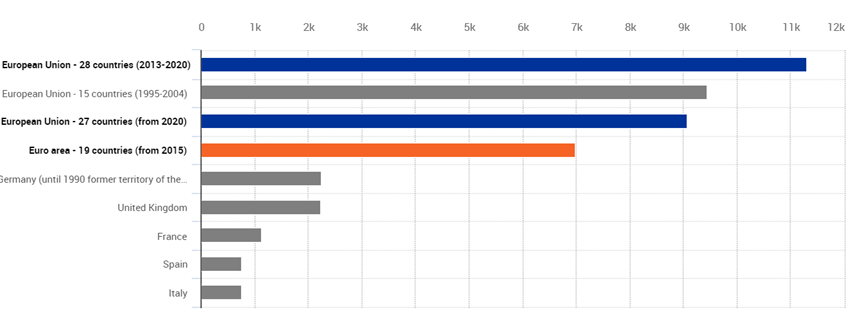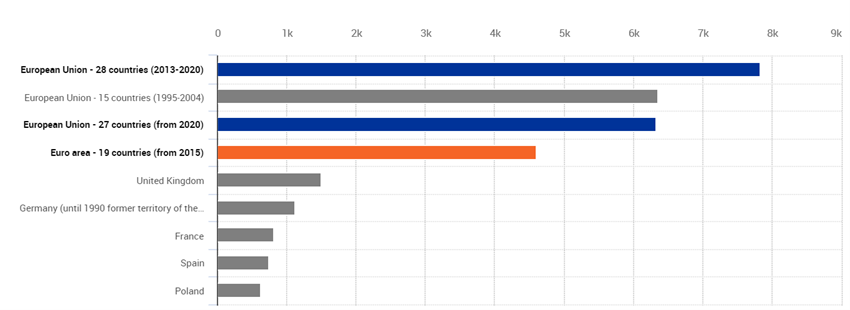11th of February: International Day of Women and girls in Science
Women in STEM fields
Last 11th of February, we celebrated International day of Women and Girls on science, day to fulfil the and to encourage the equal opportunities among genders in STEM fields.
Along the years, women have improved their positions in representations, payments, awards, and publications. However, the differences in STEM fields have remained a truth, women have been underrepresented in this field, and tendences show us that still these careers are conducted mostly by men.
Even if the position of women is continuously growing, nowadays the comparison in genders of the world population pursuing STEM careers is still unequal. In the following charts, the data of Human Resources in Science and Technologies comparing men to women show the inequality of people employed in sciences and technologies in 2020 around Europe.


About scientific publications, we also find that on average, among Web of Science registered publishers in 2020, male scientists publish 13.2 papers during their career, while female authors publish only 9.6, which leads to a 27% gender gap in total productivity (Junming Huan et.al).
PersonalizeAF, as a MSCA project, aims to promote equal opportunities between men and women in the implementation of the action, extending the gender balance to all levels. This was also included as one of the main goals of H2020 actions.
One of our dissemination objectives is to encourage biomedical and bioengineering vocational careers among young students, with special emphasis on women. One example we can mention in our first experiences is the percentage of researchers that applied for the 15 candidatures of ESRs. From the total of 155 researchers, we found that 63% were male and 37% were female. The percentages in gender balance show us that as a STEM related project, most of the people interested on the positions were identified as men.
In order to better understand the situation and to encourage girls and women to choose and be successful in STEM careers, we involved the whole consortium: all the researchers involved in PersonalizeAF network were asked about their beliefs, experiences, and suggestions, through different questions.
The experiences of our women researchers
First of all, we asked our female investigators about their experiences as women scientists since we are surrounded by exceptional women specialized in different fields such as engineering, pharmacology, medicine, or biology.
The researchers were passionate from the beginning, and confident that they could be wherever they aim to be. However, the general opinion was the importance of having more women in the decision taking spheres, but the difficulties of women to arrive to these spheres. As one researcher said, “what I realized during my scientific experience is that the more you proceed with the career, the less you are surrounded by women”. Wondering about why this happen, one of our ESRs said “Being a woman in Science means that you must “shout” to be listened by men. And in case you don’t, your opinion will be considered only once another man will support your idea”. Most of the decision-making positions of science are still occupied by the masculine gender, and this could be a strong and negative message to the young women who would like to take the leap in this career.
With the progress of the career, women also have the difficulty to combine professional and personal life in a world where children care still relapses mostly on them. As one of our experienced scientists said, “promotion and top-impact science requires a dedication that makes it more difficult for women with children, since a “normal” time dedication is not enough, and it is difficult to combine care of children with a 100%-time dedication. While this could apply the same for men with children the reality is that it is more difficult for women to skip their family obligations, sometimes because of a personal choice and sometimes because they have no other option”.
We know the number of women studying science keeps growing year by year. Why do you think still now less women decide to study Science or Engineering?
About this, the general opinion was that gender stereotypes are the main reasons that still discourage women to choose STEM careers. About that, the studies variate of what are the reasons. One example could be the wrong idea about the abilities or skills of women. About this, it has been found that one of the reasons of women not entering in STEM careers or leaving the STEM path is because they are bombarded with socialized ideas and negative stereotypes about their abilities (Gunderson, 2011).
The answers received pointed in the same direction: “Due to the cultural background that our society is based on, there is a still unconsciously correlation among scientific skills and male gender”. “The general idea was that women are assigned to an emotional or tender role, therefore they grow up with this environment, that can lead them to more “socially related” or “care related” as it can be the health environments, therefore, this would discourage girls to pursue STEM careers, making them think that Science or Engineering can be more “manly” than others”. Also, as it was seen in the article mentioned below,
“Teachers and parents (perhaps unwillingly) influence young women to believe they are not good enough to pursue paths in science, or they didn’t find female role models in STEM”. This led us to think that role models and encouragement from early ages, from families and educators can be one of the main tools to empower girls to get interested in STEM fields.
Why do you think it is important to inspire young women to study or start a career in STEM? How would you inspire or motivate young women to study or start their career in STEM?
The responses on the necessity here have gone to the same direction, all of them unanimously said that diversity and collaboration enrich all fields, also STEM and research: “STEM field benefits from diversity, contributing to create a richer creative environment for the development of scientific ideas, bringing more interesting insights and questions”, or “The presence of women in the scientific and engineering communities contributes to this goal and can improve the quality of the work being conducted”. Moreover, the researchers of PersonalizeAF have clear mind than STEM careers can be a great and fulfilling career option, therefore they encourage all genders to chase it. Because to reach progress in any field the chances to success are more if more people are involved and more minds work together towards the same goal.
When it comes to innovation, knowledge, generation of ideas, progress, and development we simply cannot afford leaving behind half of the population. “Everybody’s contribution could be revolutionary, and we must not allow any of these contributions to be lost just because of gender issues”.
About how to motivate young women to study or start the career in Science or Engineering, there was no easy answer, since this is a problem that it is still being not solved. However, a lot of women respondents stated the importance of having role models, in family or in classroom: “develop an interest in the field early on and to make the study and work environments friendly towards women. This includes, among others, the possibility to get in touch with scientific experiments at a young age and being stimulated to be curious and explore this curiosity” or “I needed a female figure close to me, a scientific woman who could drag me in this obstacle course called research”.
The opinions of the educational research of Reinking (Ana Reinking et. al.), together with the opinions of our researchers, underline the importance of the exposure to Role models in STEM (gender-neutral and also targeted to girls) and the visualization of the women in Science: “This may make little girls consider themselves as scientists/engineers in the future. If we get to do this, then Science/Engineering is engaging enough by itself to attract people”. This, together with the removal of misconceptions on gender and careers, will definitely encourage and inspire woman and girls around the worlds.
In short, the importance of the impact and influence that women researchers and women related to STEM fields can have on girls and women can be crucial to break down the gender stereotypes. This is something to stop and think about. We finalise this analysis with the words of one of our women researchers.
“The best way to motivate someone is to transmit your passion. The way I would do it would be simply telling them the way I feel about what I do: even in my small little everyday life, I feel part of something bigger than myself.”
Thanks to the PersonalizeAF network for giving us their opinions.
To learn more about how to promote gender equality in STEM: https://ec.europa.eu/research/swafs/pdf/pub_gender_equality/prages-guidelines_en.pdf
References
· Charlesworth, T., Banaji, M.R., ( 2019), Gender in Science, Technology, Engineering and Mathematics: Issues, Causes, Solutions, J Neurosci, 39(37): 7228-7243 (https://www.ncbi.nlm.nih.gov/pmc/articles/PMC6759027/ )
· Gunderson, E. A., Ramirez, G., Levine, S. C., & Beilock, S. L. (2011). The role of parents and teachers in the development of gender related math attitudes. Sex Roles, 66(3), 153-166.
· Junming Huang, A., Sinatra R., Barabási, A., (2020), Historical comparison of gender ineqauality in scientific careers across countries and disciplines. PNAS, 117 (9) 4616. (https://naerjournal.ua.es/article/view/v7n2-10#)
· Eurosat Charts: HRST by category, sex, and NUTS 1 regions [HRST_ST_RSEX__custom_558876]
· Guidelines for Gender Equality Programmes in Science:https://ec.europa.eu/research/swafs/pdf/pub_gender_equality/prages-guidelines_en.pdf
Do not miss the video we prepared to thank our women researchers in PersonalizeAF!
Follow us in our social media accounts to stay tuned, and contact to personalizeAF@itaca.upv.es if you want to know more about our project!
